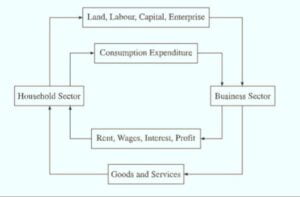Answer the following
1. Explain the two-sector model of the circular flow of national income.
Answer: – Two sector model of Circular flow of National Income: There are two sectors, households and firms. It divides the diagram into two parts. The upper half represents the factor market and the lower half represents the commodity market. Fig. explains the circular flow of income and expenditure in a two-sector model.
In the above figure the factors of production flow from the households to the firms. The firms use these factors to produce goods and services required by households. Thus, goods flow from the households to the firms and from the firms back to the households. It is called product flows. In the same way, money flows from the firms to the households in the form of factor payments such as rent, wages, interest and profit. Households use this income to purchase goods and services. Thus, money flows from the firms to the households and from the households back to the firms. It is called money flows. In the circular flow of income, production generates factor income, which is converted into expenditure. This flow of income continues as production is a continuous activity due to never-ending human wants.
2. Explain the importance of national income.
Answer: – The following points explain the importance of the National Income:
Useful for the Economy: National income data are important for the economy of a country. In present times, the national income data are regarded as accounts of the economy, which are known as ‘Social Accounts’. It tells us how the aggregates of a nation’s income, output, and product result from the income of different individuals, products of industries, and transactions of international trade.
National policies: National income data forms the basis of national policies such as employment policy, industrial policy, agricultural policy, etc. National Income also helps to generate economic models like growth models, investment models, etc. Thus, proper measures can be adopted to bring the economy to the right path.
Economic planning: For economic planning, data pertaining to national income is very essential. This includes data related to a country’s gross income, output, savings, investment, and consumption which can be obtained from different sources.
Economic Research: National income data are also used by the research scholars of economics. They make use of various data of the country’s input, output, income, savings, consumption, investment employment, etc., which are obtained from social accounts.
Comparison of Standard of Living: National income data helps us to compare the standards of living of people in different countries and of people living in the same country at different times.
Distribution of Income: National income statistics enable us to know about the distribution of income in the country from the data related to wages, rent, interest, and profits. We understand the disparities in the incomes of different sections of society.
3. Explain features of National Income.
Answer: – Features of National Income
Macroeconomic concept: The National income is a study of the Macroeconomics concept. It is the aggregate income of all goods and services produced in a country during a given year. It provides a clear picture of a country’s economic performance during a particular year.
Flow concept: National income is a flow concept i.e. flow of goods and services produced in the economy during a year. It varies according to variations in production within the country. National income flows only if there is productivity activity in the economy.
Real terms and Money Terms: The national income can be expressed in real terms as well as in money terms.
Real National Income: when national income is expressed as a flow of goods and services produced in the economy in a year, it is called as real national income.
Money National Income: When national income is expressed as the value of all goods and services produced in the economy during a year, it is called money national income.
Value of final goods and services: While calculating national income, only the value of final goods and services is included. The value of intermediate goods such as raw materials is not included. This is done to avoid double counting.
Transfer Income: While calculating national income, the transfer income in the form of old-age pension, unemployment allowances, scholarships, etc., is not included. The transfer income is received by receipts without providing any factor unit such as labour, capital, etc.
Financial Year: In India, the national income is estimated by the Central Statistical Organisation. It is annually estimated and measured for a financial year beginning from 1st April and ending on 31st March.
Net income from Abroad: While calculating national income the net income received from abroad are included. The net income from abroad includes the difference between exports and imports, as well as net income from investments abroad. If the net income is negative, then that amount is deducted from national income.
4. Explain the concept of Green GNP.
Answer: – Concept of Green GNP: It is defined as, “Green GNP is an indicator of sustainable use of the natural environment and equitable distribution of benefits of development.”
Gross National product does not take into consideration the cost in terms of (i) Environmental pollution, (ii) Depletion of natural resources caused by the production of output. A mere increase in GNP will not reflect an improvement in the quality of life when it increases environmental pollution or reduces available resources for future generations. So Green GNP has been introduced while measuring economic welfare.
The following are the characteristics of Green GNP:
a. Sustainable economic development, i.e. development which should not cause environmental degradation (pollution) and depletion of natural resources.
b. Equitable distribution of benefits of its development.
c. Promotes economic welfare for a long period of time.
Measurement: Green GNP = GNP – (Net fall in the stock of natural capital + pollution load.)
